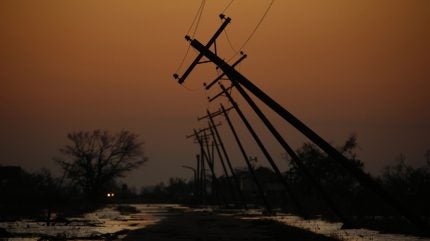
Just two weeks after Hurricane Helene knocked out power for more than 750,000 homes in south-eastern US, the state of Florida is facing yet more outages as another record-breaking hurricane barrels inland from the Gulf of Mexico.
Hurricane Milton made landfall in Florida overnight on Wednesday (9 October) as a category three hurricane, leaving more than 3.4 million homes and businesses without power in the state as of Thursday (10 October) afternoon, reduced to 2.4 million as of Friday (11 October) morning.
Power utility Florida Power & Light has faced the most outages, leaving more than 1.2 million customers without power.
Georgia and North Carolina continue to grapple with power disruptions following Helene, with over 100,000 homes and businesses without power as of Thursday afternoon, according to PowerOutage.us. This figure has come down to 72,000 as of Friday morning.
Ian Palao, vice-president of strategic energy services and in-house meteorologist at POWWR, a global energy and utilities software provider, said: “The strong wind field right at landfall will likely have snapped all power poles in the immediate area. Even as the storm loses strength as it moves across the peninsula, power poles and lines will come down. I would expect multiple thousands of poles will need replacement across the peninsula.”
According to NASA, Milton is the fastest Atlantic hurricane to intensify from a tropical depression to a category five hurricane, taking just over 48 hours. President Joe Biden said the storm is “expected to be one of the most and worst destructive hurricanes to hit Florida in over a century”.
Palao added: “Unfortunately, Milton is a much stronger storm than Helene and is making landfall in a much more populated area. I would expect damage to be quite severe from storm surge, flooding because of high rain rates, electric utility pole and wire damage from high winds, and general damage to homes and businesses from spin-up tornadoes.”
Some parts of Florida have already been inundated with up to 18in of rain, which has been termed a “one in a thousand year rainfall event” for St Petersburg. The hurricane has also led to several tornadoes.
Operations are under way to restore services across affected areas.
Palao said: “At this point, all utilities can do is to secure extra crews for the extended repair that will be necessary in the upcoming weeks. I would expect 2,000–3,000 crews to have been called into the area. It then becomes an exercise in logistics, positioning the crews correctly and safely to maximise manpower.”
For example, Duke Energy Florida, an energy services provider, announced that it was mobilising more than 10,000 responders to prepare for the outages. Duke Energy Florida storm director Todd Fountain said: “Despite extensive system improvements and rigorous tree trimming, the strong winds and flooding will cause power outages. Customers should expect significant damage and make immediate preparations for extended power outage durations.”
Rising climate risk threatens global power systems
Hurricane Milton is the ninth hurricane of the Atlantic hurricane season, which runs from 1 June to 30 November every year, and marks a period when tropical and subtropical cyclones are most likely to form over the North Atlantic ocean.
Hurricane Beryl, which made landfall in July 2024, was the earliest category five hurricane ever recorded, making this season an unprecedented one.
Experts advise that businesses brace for record hurricanes from the North Atlantic at unusually early or delayed times this year due to record-breaking sea temperatures and climate change.
Weather events like hurricanes and cyclones batter and damage power infrastructure. As the climate crisis intensifies and fuels more damaging disasters, this risk increases.
According to analysis published in July 2024, the risk of hurricane-induced power outages could become 50% higher in some areas of the US in the upcoming decade because of the climate crisis.
A report also found that climate change-driven sea level rise will expose more than 1,600 critical infrastructure assets across US coasts, from potential damage to power plants and electrical substations to “disruptive” flooding at least twice a year.
This is a global concern; for example, earlier this year, torrential rains in Brazil’s Rio Grande De Sul not only left more than half a million people without power but also triggered a hydroelectric dam collapse. According to grid operator ONS, three substations, 25 transmission lines, five hydroelectric plants and 11 power transformers were taken offline.
For more on the Atlantic hurricane season, here’s GlobalData’s Instant Insights podcast.
How can power grids become more resilient?
According to a 2024 study that modelled storm damages to the Texas power system, protecting a small but critical part of the power grid against storm damage can prevent large-scale power outages caused by tropical cyclones.
The report states: “We show that hardening only 1% of total lines can reduce the likelihood of the most destructive type of outage by a factor of between 5 and 20.”
Christian Otto, the study’s author and Potsdam Institute for Climate Impact Research PIK scientist, said in a statement: “We found that the failures of certain lines can trigger large-scale outages affecting whole regions or cities. Regions or cities fail in one major cascade, rather than gradually.
“Our research shows that such cascades can be avoided almost entirely if less than 1% of the overall grid – this is 20 lines in the case of the Texas power grid – is protected against storm damages; for example, by reinforcing transmission towers or using underground cables.”
The International Energy Agency also recommends including climate resilience in construction plans and operational regimes. Recommended measures include physical system hardening of electricity systems through technical and structural improvements to power plants or distribution networks; enhanced visibility and controllability in systems operation with advanced weather forecasting; application of islanding schemes; and smart grid technologies.



